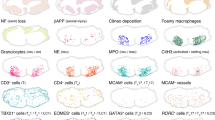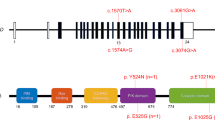Abstract
Background
The detection of antibodies to myelin oligodendrocyte glycoprotein (MOG) is fundamental for the identification of MOG antibody-associated disorders (MOGAD), and the differential diagnosis of acquired demyelinating syndromes of the CNS, among which multiple sclerosis (MS). We compared the diagnostic performance of four cell-based assays (CBAs) for their detection.
Methods
Consecutive sera from 204 patients with ‘possible MOGAD’ (55), MS (112), and other neurological disorders (OND, 37) were tested for MOG-IgG with a live-CBA with anti-heavy-and-light chain secondary-antibody (LCBA-IgGH+L), and a live-CBA for IgG1 (LCBA-IgG1). A subgroup of 71 patients was additionally tested with a live-CBA with anti-Fcγ secondary-antibody (LCBA-IgGFcγ), and a commercial fixed-CBA with anti-Fcγ secondary-antibody (FCBA-IgGFcγ).
Results
Fifty-seven/204 patients (27.9%) were MOG-IgG-positive. Sensitivity was 89.1% (CI:77.8–95.9) and specificity 93.3% (CI:88.0–96.7) for LCBA-IgGH+L, and 74.6% (CI:61.0–85.3) and 100% (CI:97.6–100) for LCBA-IgG1. Eighteen of 57 (31%) samples showed discrepant results (all negative on LCBA-IgG1); of these, three with ‘possible MOGAD’ showed high-titer MOG-IgG (≥ 1:640), and positivity for MOG-IgG2, whereas 15/18 had low-titer MOG-IgG (1:160/1:320) and mixed diagnoses (5 ‘possible MOGAD’, 6 MS, 4 OND). In the subgroup analysis, sensitivity was 92.3% (CI:79.1–98.4) and specificity 97.0% (CI:83.8–99.9) for LCBA-IgGFcγ, and 87.2% (CI:72.6–95.7) and 97.0% (CI:83.8–99.9) for FCBA-IgGFcγ.
Conclusions
LCBA-IgG1 showed the highest specificity but can miss MOG-IgG2 reactivities, whose meaning warrants further investigations. Titration of samples tested with LCBA-IgGH+L/ IgGFcγ is important for meaningful interpretation of the results. In the subgroup analysis, LCBA-IgGFcγ yielded the highest accuracy, and FCBA-IgGFcγ good specificity, but it was at risk of false-negative results.



Similar content being viewed by others
Data availability
All data from the present study are available upon request to the corresponding author.
References
Pham-Dinh D, Mattei MG, Nussbaum JL et al (1993) Myelin/oligodendrocyte glycoprotein is a member of a subset of the immunoglobulin superfamily encoded within the major histocompatibility complex. Proc Natl Acad Sci U S A 90:7990–7994. https://doi.org/10.1073/pnas.90.17.7990
Jarius S, Paul F, Aktas O et al (2018) MOG encephalomyelitis: international recommendations on diagnosis and antibody testing. J Neuroinflamm 15:134. https://doi.org/10.1007/s00115-018-0607-0
Linington C, Bradl M, Lassmann H et al (1988) Augmentation of demyelination in rat acute allergic encephalomyelitis by circulating mouse monoclonal antibodies directed against a myelin/oligodendrocyte glycoprotein. Am J Pathol 130:443–454
Karni A, Bakimer-Kleiner R, Abramsky O, Ben-Nun A (1999) Elevated levels of antibody to myelin oligodendrocyte glycoprotein is not specific for patients with multiple sclerosis. Arch Neurol 56:311–315. https://doi.org/10.1001/archneur.56.3.311
Lindert RB, Haase CG, Brehm U et al (1999) Multiple sclerosis: B- and T-cell responses to the extracellular domain of the myelin oligodendrocyte glycoprotein. Brain 122:2089–2100. https://doi.org/10.1093/brain/122.11.2089
Reindl M, Linington C, Brehm U et al (1999) Antibodies against the myelin oligodendrocyte glycoprotein and the myelin basic protein in multiple sclerosis and other neurological diseases: a comparative study. Brain 122:2047–2056. https://doi.org/10.1093/brain/122.11.2047
Berger T, Rubner P, Schautzer F et al (2003) Antimyelin antibodies as a predictor of clinically definite multiple sclerosis after a first demyelinating event. N Engl J Med 349:139–145. https://doi.org/10.1056/NEJMoa022328
Kuhle J, Pohl C, Mehling M et al (2007) Lack of association between antimyelin antibodies and progression to multiple sclerosis. N Engl J Med 356:371–378. https://doi.org/10.1056/NEJMoa063602
von Büdingen HC, Hauser SL, Ouallet JC et al (2004) Frontline: Epitope recognition on the myelin/oligodendrocyte glycoprotein differentially influences disease phenotype and antibody effector functions in autoimmune demyelination. Eur J Immunol 34:2072–2083. https://doi.org/10.1002/eji.200425050
O’Connor KC, McLaughlin KA, De Jager PL et al (2007) Self-antigen tetramers discriminate between myelin autoantibodies to native or denatured protein. Nat Med 13:211–217. https://doi.org/10.1038/nm1488
Sepulveda M, Armangue T, Martinez-Hernandez E et al (2016) Clinical spectrum associated with MOG autoimmunity in adults: significance of sharing rodent MOG epitopes. J Neurol 263:1349–1360. https://doi.org/10.1007/s00415-016-8147-7
Mader S, Gredler V, Schanda K et al (2011) Complement activating antibodies to myelin oligodendrocyte glycoprotein in neuromyelitis optica and related disorders. J Neuroinflamm 8:184. https://doi.org/10.1186/1742-2094-8-184
Reindl M, Waters P (2019) Myelin oligodendrocyte glycoprotein antibodies in neurological disease. Nat Rev Neurol 15:89–102. https://doi.org/10.1038/s41582-018-0112-x
Kitley J, Woodhall M, Waters P et al (2012) Myelin-oligodendrocyte glycoprotein antibodies in adults with a neuromyelitis optica phenotype. Neurology 79:1273–1277. https://doi.org/10.1212/WNL.0b013e31826aac4e
Hacohen Y, Wong YY, Lechner C et al (2018) Disease course and treatment responses in children with relapsing myelin oligodendrocyte glycoprotein antibody–Associated disease. JAMA Neurol 75:478–487. https://doi.org/10.1001/jamaneurol.2017.4601
Waters P, Fadda G, Woodhall M et al (2019) Serial anti-myelin oligodendrocyte glycoprotein antibody analyses and outcomes in children with demyelinating syndromes. JAMA Neurol. https://doi.org/10.1001/jamaneurol.2019.2940
Jarius S, Ruprecht K, Kleiter I et al (2016) MOG-IgG in NMO and related disorders: a multicenter study of 50 patients Part 1: frequency, syndrome specificity, influence of disease activity, long-term course, association with AQP4-IgG, and origin. J Neuroinflamm 13:279. https://doi.org/10.1186/s12974-016-0717-1
Jarius S, Ruprecht K, Kleiter I et al (2016) MOG-IgG in NMO and related disorders: a multicenter study of 50 patients. Part 2: epidemiology, clinical presentation, radiological and laboratory features, treatment responses, and long-term outcome. J Neuroinflamm 13:280. https://doi.org/10.1186/s12974-016-0718-0
Jarius S, Kleiter I, Ruprecht K et al (2016) MOG-IgG in NMO and related disorders: a multicenter study of 50 patients. Part 3: Brainstem involvement - frequency, presentation and outcome. J Neuroinflamm 13:281. https://doi.org/10.1186/s12974-016-0719-z
Cobo-Calvo A, Ruiz A, Maillart E et al (2018) Clinical spectrum and prognostic value of CNS MOG autoimmunity in adults: the MOGADOR study. Neurology 90:e1858–e1869. https://doi.org/10.1212/wnl.0000000000005560
Jurynczyk M, Messina S, Woodhall MR et al (2017) Clinical presentation and prognosis in MOG-antibody disease: a UK study. Brain 140:3128–3138. https://doi.org/10.1093/brain/awx276
Wingerchuk DM, Banwell B, Bennett JL et al (2015) International consensus diagnostic criteria for neuromyelitis optica spectrum disorders. Neurology 85:177–189. https://doi.org/10.1212/WNL.0000000000001729
López-Chiriboga AS, Majed M, Fryer J et al (2018) Association of MOG-IgG serostatus with relapse after acute disseminated encephalomyelitis and proposed diagnostic criteria for MOG-IgG-associated disorders. JAMA Neurol 75:1355–1363. https://doi.org/10.1001/jamaneurol.2018.1814
Haase CG, Guggenmos J, Brehm U et al (2001) The fine specificity of the myelin oligodendrocyte glycoprotein autoantibody response in patients with multiple sclerosis and normal healthy controls. J Neuroimmunol 114:220–225. https://doi.org/10.1016/S0165-5728(00)00462-8
Lalive PH, Menge T, Delarasse C et al (2006) Antibodies to native myelin oligodendrocyte glycoprotein are serologic markers of early inflammation in multiple sclerosis. Proc Natl Acad Sci USA 103:2280–2285. https://doi.org/10.1073/pnas.0510672103
Zhou D, Srivastava R, Nessler S et al (2006) Identification of a pathogenic antibody response to native myelin oligodendrocyte glycoprotein in multiple sclerosis. Proc Natl Acad Sci USA 103:19057–19062. https://doi.org/10.1073/pnas.0607242103
Waters P, Woodhall M, O’Connor KC et al (2015) MOG cell-based assay detects non-MS patients with inflammatory neurologic disease. Neurol Neuroimmunol NeuroInflammation 2:e89. https://doi.org/10.1212/NXI.0000000000000089
Di Pauli F, Mader S, Rostasy K et al (2011) Temporal dynamics of anti-MOG antibodies in CNS demyelinating diseases. Clin Immunol 138:247–254. https://doi.org/10.1016/j.clim.2010.11.013
Waters PJ, Komorowski L, Woodhall M et al (2019) A multicenter comparison of MOG-IgG cell-based assays. Neurology 92:e1250–e1255. https://doi.org/10.1212/wnl.0000000000007096
Thompson AJ, Banwell BL, Barkhof F et al (2018) Diagnosis of multiple sclerosis: 2017 revisions of the McDonald criteria. Lancet Neurol 17:162–173. https://doi.org/10.1016/s1474-4422(17)30470-2
Barkhof F, Filippi M, Miller DH et al (1997) Comparison of MRI criteria at first presentation to predict conversion to clinically definite multiple sclerosis. Brain 120:2059–2069. https://doi.org/10.1093/brain/120.11.2059
Gastaldi M, De Rosa A, Maestri M et al (2019) Acquired neuromyotonia in thymoma-associated myasthenia gravis: a clinical and serological study. Eur J Neurol 26:992–999. https://doi.org/10.1111/ene.13922
Mariotto S, Ferrari S, Monaco S et al (2017) Clinical spectrum and IgG subclass analysis of anti-myelin oligodendrocyte glycoprotein antibody-associated syndromes: a multicenter study. J Neurol 264:2420–2430. https://doi.org/10.1007/s00415-017-8635-4
Reindl M, Schanda K, Woodhall M et al (2020) (2020) International multicenter examination of MOG antibody assays. Neurol Neuroimmunol Neuroinflamm 7:e674. https://doi.org/10.1212/NXI.0000000000000674
McCracken L, Zhang J, Greene M et al (2017) Improving the antibody-based evaluation of autoimmune encephalitis. Neurol Neuroimmunol Neuroinflamm 4:e404. https://doi.org/10.1212/nxi.0000000000000404
Waters P, Reindl M, Saiz A et al (2016) Multicentre comparison of a diagnostic assay: aquaporin-4 antibodies in neuromyelitis optica. J Neurol Neurosurg Psychiatry 87:1005–1015. https://doi.org/10.1136/jnnp-2015-312601
Mariotto S, Gajofatto A, Batzu L et al (2019) Relevance of antibodies to myelin oligodendrocyte glycoprotein in CSF of seronegative cases. Neurology 93:e1867–e1872. https://doi.org/10.1212/WNL.0000000000008479
Acknowledgements
We thank Mark Woodhall and Angela Vincent for the support in implementing the CBAs used for this study.
Funding
This work was supported by the Italian Ministry of Health ‘Ricerca Corrente’ 2017–2019 Grant (Grant code: RC1812C) to the IRCCS Mondino Foundation.
Author information
Authors and Affiliations
Corresponding author
Ethics declarations
Conflicts of interest
GM received honoraria for participation to advisory boards from Roche. The Pavia neuroimmunology laboratory receives payments for antibody assays (MOG, AQP4, and other autoantibodies) The University Hospital and Medical University of Innsbruck (Austria) receives payments for antibody assays (MOG, AQP4, and other autoantibodies) and for MOG and AQP4 antibody validation experiments organized by Euroimmun (Lübeck, Germany). WP and the University of Oxford hold patents and receive royalties for antibody assays. MOG antibody tests are performed in his laboratory. WP has received speaker or consulting honoraria from Alexion and UBC.
Ethics approval and consent to participate
The local ethics committee approved this study. All included patients, or their legal representatives, gave written consent for the retrospective analysis of their medical records.
Consent for publication
All co-authors approved the final version of this document.
Rights and permissions
About this article
Cite this article
Gastaldi, M., Scaranzin, S., Jarius, S. et al. Cell-based assays for the detection of MOG antibodies: a comparative study. J Neurol 267, 3555–3564 (2020). https://doi.org/10.1007/s00415-020-10024-0
Received:
Revised:
Accepted:
Published:
Issue Date:
DOI: https://doi.org/10.1007/s00415-020-10024-0




